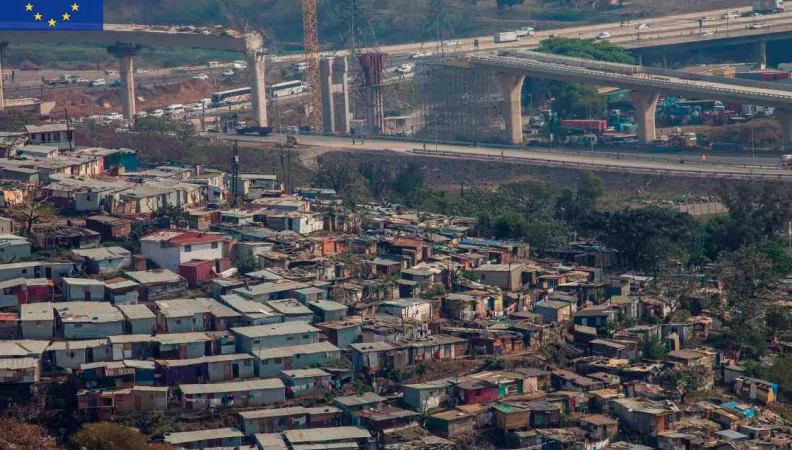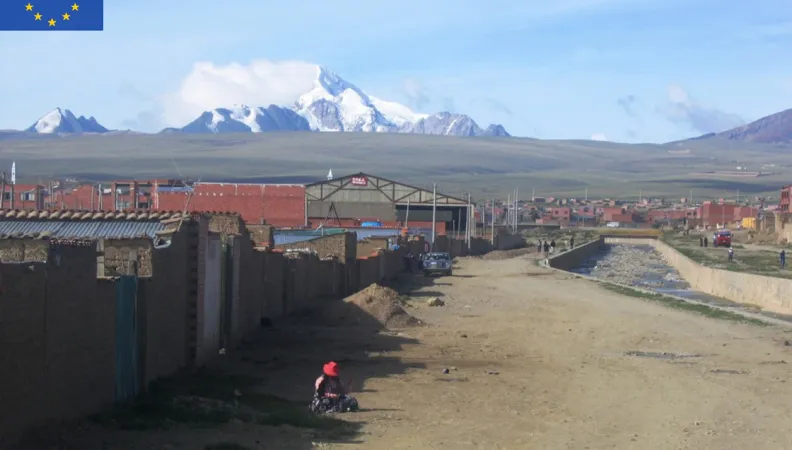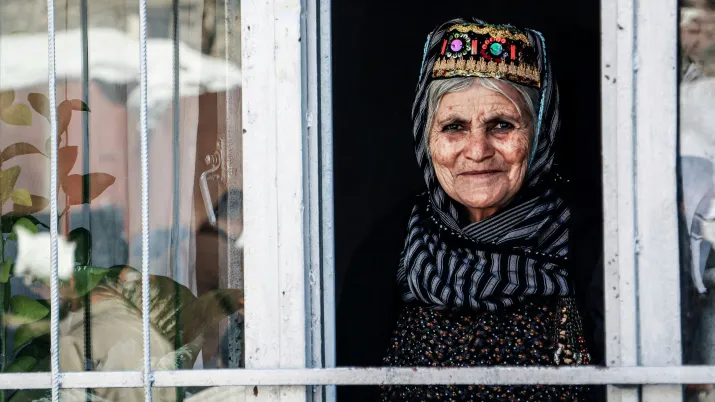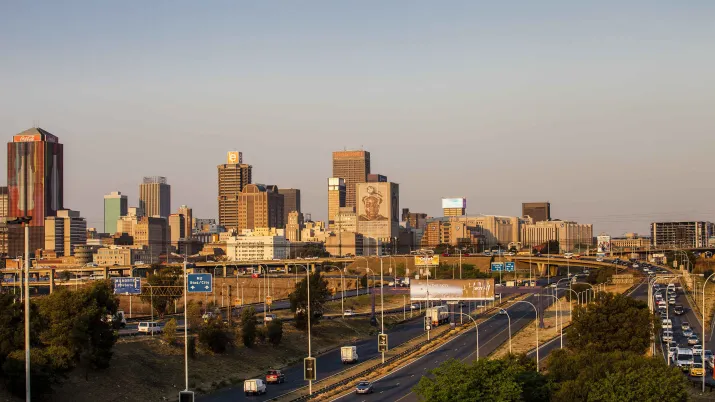 Legal notice EU (project) Inequality has emerged as the social challenge of the decade. Empirically, a series of influential studies of the available international evidence suggest that global inequality has been falling in the last quarter century. However, this encouraging trend appears to have been driven entirely by convergence in GDP per capita across nations and the consequent decline in inequality between countries, with the average inequality within countries remaining constant until the about 2000 but increasing thereafter.
Legal notice EU (project) Inequality has emerged as the social challenge of the decade. Empirically, a series of influential studies of the available international evidence suggest that global inequality has been falling in the last quarter century. However, this encouraging trend appears to have been driven entirely by convergence in GDP per capita across nations and the consequent decline in inequality between countries, with the average inequality within countries remaining constant until the about 2000 but increasing thereafter.
Context
The picture within Africa is more complex, and often obscured by problems with unreliable and non-comparable data, both over time and across countries. The most careful African data analysis suggests that, measured in monetary terms, African inequality is very high, Africa being the most unequal continent. There is, however, huge variation in the magnitude, changes and texture of this inequality across the continent.
This implies a double danger. Africa first needs to ensure that it is included in the international measurements. At least as importantly, the continent must also ensure that the particular contexts of its societies are considered in the analysis both of the factors causing inequality and the consequences of inequality. This analysis is absolutely crucial because it is the basis for policy interventions and civil society action, which are necessary to reverse the trend.
Given this context, a research project focusing on the development of diagnostic tools and capacity building was launched in partnership with the African Center of Excellence on Inequality Research (ACEIR) in the framework of the first phase of the Research Facility on Inequalities. The initial study (2018-2020) led to an in-depth analysis of inequalities in four countries: South Africa, Ghana, Kenya and Cote d’Ivoire. A Handbook on Inequality Measurement, which serves as a foundational guide for multidimensional inequality analysis, was also developed by ACEIR. The Handbook outlines key dimensions and indicators of inequality and provides guildelines for measuring income and beyond income inequalities.
This project was part of the first phase of the Research Facility on Inequalities, coordinated by AFD and funded by the European Commission's Directorate-General for International Partnerships over the 2017-2020 period. The first phase of the Facility has led to the conduct of 22 research projects and the publication of around 100 research papers and policy briefs.
Following the success of this research project:
- A fifth analysis was launched in Mozambique over the 2022-2024 period;
- A research project aming to expand and update the Handbook by incorporating methodologies for assessing vulnerabilities related to climate change and ecological transitions has also been launched over the 2024-2025 period.
Find out more
Goals
The main objective of this research project was to advance the analysis of African inequality and the policy discussion on strategies to overcome inequality in Africa through a series of country-level engagements. The project was given structure and impetus through the development of a diagnostic tool that was implemented in a limited number of pilot countries. This diagnostic tool consists of a thorough analysis of the various inequalities in a given country which enables the government to identify the priorities and policy options in order to reduce them.
In order to build the diagnostic tool, a Handbook was also developed to set up a common base which enabled country comparisons. To extend its use and improve accountability, it was backed with a central data hub and strong data centres in each partner country that allowed and facilitated further inequality analysis.
Existing multidimensional inequality analyses primarily concentrate on examining inequalities within the social and economic domains. While many low-income countries are severely impacted by climate change, there is a notable research gap in the analysis of inequalities related to climate vulnerabilities and their interactions with other socio-economic and environmental factors. The extension and updating of the Handbook, carried out over the period 2024-2025, aims to address this gap and provide the guidelines for integrating the analysis of climate-related inequalities in future diagnostics.
Method
The diagnostic tool is based on three pillars :
- a conceptual and empirical review of the studies on inequality in Africa, allowing us to have a baseline for the development of future projects, as well as a better comprehension of the specificities of inequalities in Africa and of their measurement;
- a Handbook which contains the framework proposed for the country inequality diagnostics, the methodological issues around the measurement of inequalities and their analysis and the important issues linked to policies;
- the support to the implementation of the country diagnostic, in collaboration with the pilot countries’ local research teams and the creation of the data hub.
In order to expand and update the Handbook, researchers will thoroughly examine and synthesise existing literature that addresses the measurement and analysis of climate-related vulnerabilities. This approach will help identify gaps in current research and propose a minimal set of indicators for measuring vulnerabilities linked to climate change and the imperatives of the ecological transition and detail appropriate data and measurement methods to enable their inclusion as part of an inequality diagnostic report.
Results
In practical terms, the country diagnostic takes the form of a report which overviews the inequality within a country, across all relevant dimensions, for a given time and over time. Alongside this, it summarises the main policies passed, or in place, expected to have an impact on inequalities. Each country will use their diagnostic as a platform:
- for policy engagements on strategies to overcome inequality,
- for the stimulation of national dialogue and a national research focus on inequality,
- to lead the national discussion through further, high impact research papers from the country node on inequality.
- The Handbook on Inequality Measurements for Country Studies: in order to insure a certain degree of comparability among all the country studies and to support researchers and statisticians in conducting inequality diagnostics, a Handbook was developed by the African Centre of Excellence for Inequality Research (ACEIR).
- A review on inequality in Sub-Saharan Africa: this research paper takes stock of what we know about African inequality both to promote better analysis and better policymaking in addressing inequality in Africa.
- The diagnostic of inequality in South Africa, carried out by Statistics South Africa in partnership with the Southern Africa Labour and Development Research Unit (SALDRU), ACEIR in the EU-AFD Facility framework: Inequality trends in South Africa: a multidimensional diagnosis of inequality
This report was presented at a workshop involving all actors working to reduce inequality (11 February 2020 in Philippi, Cape Town), on the occasion of the 30th anniversary of the release of Nelson Mandela. You will find here the synthesis of the workshop here: Stakeholder engagement on inequality trends in South Africa.
- The diagnostic of inequality in Ghana, conducted by ISSER and the University of Ghana in partnership with the ACEIR in the EU-AFD Facility framework: Inequality Diagnostics for Ghana
- The diagnostic of inequality in Kenya, conducted by University of Nairobi in partnership with ACEIR in the EU-AFD Facility framework: Inequality Diagnostics for Kenya
- An in-depth analysis of inequality in Côte d'Ivoire (in French)
Several analyses have been conducted in partnership with local research centres:
- An analysis on the dynamics of social inequalities in Mozambique, conducted by Instituto de estudos sociais e economicos (IESE) and the University of Cape Town in partnership with ACEIR in the EU-AFD Facility framework
- The multidimensional diagnostic on inequalities in Colombia, conducted in close collaboration with Fedesarrollo and DANE
- The multidimensional diagnostic on inequalities in Indonesia, conducted in close collaboration with LPEM and BPS-Statistics.
The research project aiming to expand and update the Handbook will result in:
- A research paper that conceptualizes the links between inequalities, climate change and the ecological transition in low and middle income countries (in progress);
- An updated edition of the Inequality Handbook that integrates key metrics of climate change's impact on inequality (in progress).
Contacts
- Anda David, Research Officer, AFD
- Rawane Yasser, Junior Research Officer, AFD
 Legal notice EU (project) Inequalities in urban water services are often perceived simplistically, according to a binary interpretation of “access/non-access,” with an end goal of making access to this public service universal. In other words, the issue has long been to ensure that all inhabitants enjoy access to water via a public service. This is all the more true in Bolivia, where water is considered as a “common good” subject to a principle of “non-commodification,” written in the country’s constitution since 2009. But the 2016 water crisis in La Paz has highlighted a new type of inequality in terms of water-supply service. During that drought episode, it was the inhabitants of the neighborhoods in the southern part of La Paz, where people from the middle and upper classes live, who were more exposed to the weakness of the main system of water access and who were deprived of water service. This shows one of the many possible variations in inequality in urban water services, the analysis of which requires going beyond just the question of technical access to the network.
Legal notice EU (project) Inequalities in urban water services are often perceived simplistically, according to a binary interpretation of “access/non-access,” with an end goal of making access to this public service universal. In other words, the issue has long been to ensure that all inhabitants enjoy access to water via a public service. This is all the more true in Bolivia, where water is considered as a “common good” subject to a principle of “non-commodification,” written in the country’s constitution since 2009. But the 2016 water crisis in La Paz has highlighted a new type of inequality in terms of water-supply service. During that drought episode, it was the inhabitants of the neighborhoods in the southern part of La Paz, where people from the middle and upper classes live, who were more exposed to the weakness of the main system of water access and who were deprived of water service. This shows one of the many possible variations in inequality in urban water services, the analysis of which requires going beyond just the question of technical access to the network.
Context
In 2015, the level of access to “improved” water services in Bolivian cities was 97%, while that of wastewater treatment services was limited to 61%. Beyond these general data, the available data on the rates of access to water-supply services does not necessarily reveal other types of urban inequality related to water. Such inequality concerns not just technical access to the network, which, incidentally, is easily recognizable on a servicing map.
They also involve, for example, the question of inequality linked to payment for the service. This type of data is more difficult to obtain, because it is linked to household composition, usage practices, consumption level, and of course income. Another type of inequality arises from the nature of the service provider. The public water service is not the only form of provision of service in cities: there are also small socio-technical systems decentralized at the neighborhood level, which sometimes substitute for the main system or provide supplementary service. They generally offer basic service of acceptable quality and with lower rates, but require active participation by users in collective maintenance work. In addition, a new aspect of inequality is related to the location of some households more exposed than others to the weakness of the main system. This phenomenon was clearly seen during the 2016 water crisis in La Paz, whose southern neighborhoods were deprived of water service for several weeks. Other factors of inequality can be identified, such as the political tendency or social-mobilization capacity of some networks. These factors can sometimes act as real comparative advantages that can sometimes constitute real comparative advantages in the priorities of access to water services and sanitation.
This project is part of the first phase of the Research Facility on Inequalities, coordinated by AFD and funded by the European Commission's Directorate-General for International Partnerships over the 2017-2020 period. The first phase of the Facility has led to the conduct of 22 research projects and the publication of around 100 research papers and policy briefs.
Goal
This research project is being led by a multidisciplinary team under the coordination of CIDES-UMSA. It seeks to examine and analyze the various types of inequality linked to water and sanitation services in La Paz-El Alto, as well as their trends in recent years, above and beyond the typical determinants such as income (vertical inequalities) and localization (spatial inequalities). In fact, the researchers are also interested in other, less-studied types of determinants, such as exposure to climate change, social representations, and political resources, all of which can affect social cohesion. The objective is to obtain a new interpretation of urban inequalities in La Paz-El Alto, in order to fuel dialog with municipal and sectoral authorities.
This project also seeks to support Bolivian research, through training, methodology workshops, and participation in international conferences, etc.
Method
This research project follows a multi-disciplinary and multi-theme approach that combines qualitative field surveys covering different areas of the two cities, on key subjects related to i) inequality in water services (trends in services on the urban fringe, small-scale systems, socio-political resources in neighborhoods, shared uses of water in the city, etc.), ii) historical analyses (how inequality in the services started), and iii) statistical analyses. The approach also involves working in connection with the municipal research services. The results from these different surveys and analyses will be discussed regularly at workshops for sharing experiences.
Results
Find the presentation of the research paper “Inequalities related to urban water services in La Paz-El Alto, Bolivia” by Sarah Botton (AFD research officer) and Patricia Urquieta (CIDES-UMSA researcher) during the third webinar of the Research Facility on Inequalities:
You may find the research papers linked to this project here:
- An overview of inequalities in urban water services in Bolivia
- Conflicts and tensions over water ownership in the territory of the urban-rural interface of Hampaturi, municipality of La Paz
- When governance fails: institutional asymmetries in water management in the municipality of La Paz
- Landscape of springs and collective outdoor laundries in the city of La Paz
- The ‘urbanization of water’ in La Paz, Bolivia: historical and conceptual perspectives
- Persistence of inequality in access to water: a look at the actions of women in peri-urban territories of the city of El Alto
- Territorial inequalities expressed in children's health in two neighborhoods with access to water in the city of El Alto
- Corporate citizenship and water urbanization on the outskirts of El Alto
You may find the policy briefs here:
- Springs and collective laundries in the City of La Paz, notes for their management
- Access to water : persistence of inequalities in the life of women
- Municipal planning and inter-institutional coordination for good water management
- Water and Sanitation works with Neighborhood Participation: regulated and transparent
- Water provision and management of urban-rural interface territories
- Water in the city of El Alto, a right that arrives incomplete
Contact:
- Sarah Botton, Research Officer, AFD
- Patricia Urquieta, CIDES-UMSA
Contactos:
- Sarah Botton, coordinadora de investigación en la AFD
- Patricia Urquieta, profesora-investigadora CIDES-UMSA
 Legal notice EU (project) This study analyzes trends in inequalities between 2010 and 2016 in the two main Jordanian cities hosting Syrian refugees: 194,000 Syrians in Amman and 140,000 in Irbid, according to 2018 data of the United Nations Refugee Agency (UNHCR). This research project involves studying the impact of the influx of Syrians on trends in economic inequalities (incomes, growth, poverty, etc.) and on the housing market (real estate market, share of housing in household expenditures, etc.).
Legal notice EU (project) This study analyzes trends in inequalities between 2010 and 2016 in the two main Jordanian cities hosting Syrian refugees: 194,000 Syrians in Amman and 140,000 in Irbid, according to 2018 data of the United Nations Refugee Agency (UNHCR). This research project involves studying the impact of the influx of Syrians on trends in economic inequalities (incomes, growth, poverty, etc.) and on the housing market (real estate market, share of housing in household expenditures, etc.).
Context
According to the official Jordanian population census, there were an estimated 1.2 million Syrian refugees in the country as of November 2015. This figure corresponds to between 10% and 12% of the population. Approximately 660,000 of them are registered as “asylum seekers” by the UNHCR. But their number has been decreasing since 2015, probably because of migration, especially back to their home country.
The percentage of Syrian refugees who do not wish to live permanently in the three UN-run refugee camps in northern Jordan surpasses 90%. This is why they are settling in cities or the nearby rural areas, where they rent apartments and often live in unsuitable housing. Their main motivation for doing so is access to jobs.
This population influx to the cities has an impact on housing, services, activities, income, and the distribution of resources among urban residents. It can heighten the inequalities among the people living in Jordan, in particular between Jordanians and foreigners (1.7 million foreigners live in Jordan).
This project is part of the first phase of the Research Facility on Inequalities, coordinated by AFD and funded by the European Commission's Directorate-General for International Partnerships over the 2017-2020 period. The first phase of the Facility has led to the conduct of 22 research projects and the publication of around 100 research papers and policy briefs.
Objectives
The first part of the study focuses on the dynamics of economic inequality between households in Amman and Irbid, using the 2010 and 2016 Jordan Labor Market Panel Survey (JLMPS) and the 2013 and 2016 Household Expenditure and Income Survey (HEIS).
The second part of the study examines housing inequality among residents of Amman and Irbid. This section looks at both housing as a cost (household expenditures) and housing as a source of income (renting, selling, etc.).
Method
Many inequality indicators will be used: the Gini coefficient as well as the Atkinson index and the P90/P10 ratio, for example.
The data will come from:
- studies from 2010 and 2016 on the Jordanian labor market (Jordan Labor Market Panel Surveys);
- 2004 and 2015 population censuses (Jordanian Department of Statistics);
- data on household incomes and expenditures (Household Expenditure and Income Surveys, HEIS), 2013 and 2016;
- UNDP data on socio-economic inequalities in Jordan; and
- UNHCR data.
The research team is made up of two economists, one geographer, and one sociologist on the Jordanian side, and one economist and one urban planner on the AFD side.
Contacts
- Irène Salenson, Research Officer, AFD
- Abdel Baset Athamneh, Head, Department of Economics, Yarmouk University
Discover other research projects



 Legal notice EU (project) Twenty years on since independence and the end of Apartheid, South Africa is yet to emerge as a socially cohesive nation. The proposed research project aims to formulate a relevant approach for social cohesion in the case of South Africa and analyze the link between social cohesion and ethnic and racial inequalities.
Legal notice EU (project) Twenty years on since independence and the end of Apartheid, South Africa is yet to emerge as a socially cohesive nation. The proposed research project aims to formulate a relevant approach for social cohesion in the case of South Africa and analyze the link between social cohesion and ethnic and racial inequalities.
Context
Twenty years on since independence and the end of Apartheid, South Africa is yet to emerge as a socially cohesive nation. South Africans still live apart – geographically and socially – except within a few groups where the constituents share common identities such as race, ethnicity and class. Moreover, inequality continues to provoke tension – between the rich and the poor, between racial groups, between the urban metropoles and former homelands, and between farm owners and their workers. Economic growth, to the extent it has occurred, has not brought with it greater equality and cohesion in South Africa, the essential ingredient of inclusive growth.
Scholars, policy makers, opinion leaders, and citizenry of the country have been extensively debating issues surrounding the cohesiveness of South African society. Yet, the term “social cohesion” has been used loosely in academic literature and political discourse, and its meaning and its mutual dependence with economic development have not been well understood. We do not yet have a clearly defined concept – and hence definition – of social cohesion as relevant for inclusive development in South Africa. Without definition and measurement, we cannot conclusively ascertain if social cohesion has improved. Without knowing a few key levers (i.e., determinants of social cohesion), it would be difficult to formulate policies that can materially improve social cohesion and effectively achieve inclusive development.
Objectives
Against this background, the proposed research project aims to contribute to addressing social cohesion and inclusive development, two of the most fundamental challenges facing South Africa. More specifically, the objectives are to:
- formulate a relevant approach for social cohesion in the case of South Africa;
- construct and measure social cohesion indicators;
- conduct an in-depth analysis of ethnic and racial inequalities in South Africa;
- shed light on the linkages between social cohesion and inequalities and their implications for policies.
The research will combine the wealth of knowledge of top South African scholars about history, society, politics and economy of the country with the expertise of a Japanese researcher and that of the AFD’s research officers on global practices and analytical tools.
Research findings
Preliminary results from the Social Cohesion Index research suggest:
- We can operationalise a definition of social cohesion and measure it using available national data.
- There is a large degree of consistency in trends in the index and its constituent components over time across four national data sets.
- Social cohesion in South Africa increased between 2008 and 2011, although the trend thereafter is less clear and a longer time series is required.
- Higher levels of per capita income and employment are positively associated with higher social cohesion.
- Poverty, unemployment, and service delivery protest are negatively correlated with social cohesion.
- Municipal policy and competence are closely associated with higher social cohesion.
Our research shows that social cohesion hinges on overcoming prevailing prejudices, interracial mistrust, and negative attitudes towards integration. How people perceive inequality (or not) determines the likelihood of inter-racial interactions.
High levels of inequality and the perception that our inequality has not improved in the post-apartheid period are the key impediments to social cohesion in South Africa. This importance remains even when inequality is analyzed alongside other clearly critical influences such as racial, spatial, and educational factors.
There are two minimum requirements for building a cohesive society in South Africa:
- Prioritize a defined and monitored agreement to overcome poverty, inequality and social exclusion; and
- Do it in a way that actively and legitimately ensures voice and agency for marginalised individuals and communities.
Our studies of social cohesion show that these bold policies to address socio-economic challenges must include behavior and practices in everyday life that demonstrate evidence of a society that is actually committed to overcoming remaining prejudices, interracial mistrust, and negative attitudes.
To build, track, and improve social cohesion we should start by operationalising a shared definition of social cohesion that includes five dimensions (inclusion, belonging, social relationship, participation and legitimacy).
Publications
Discover other research projects on inequalities




